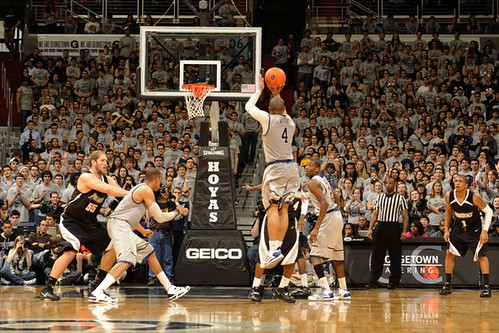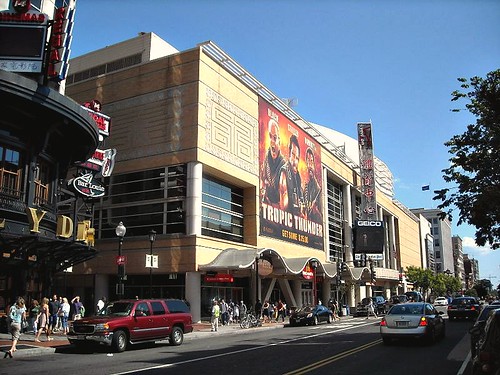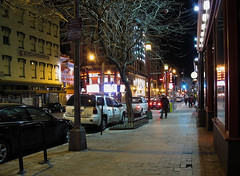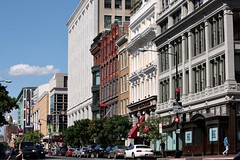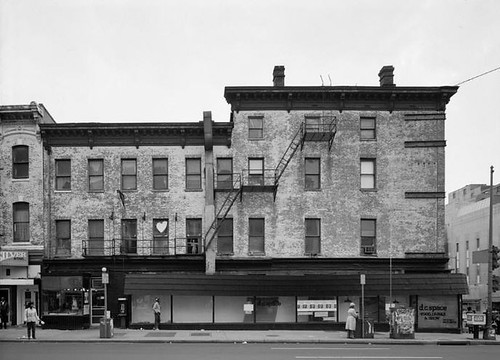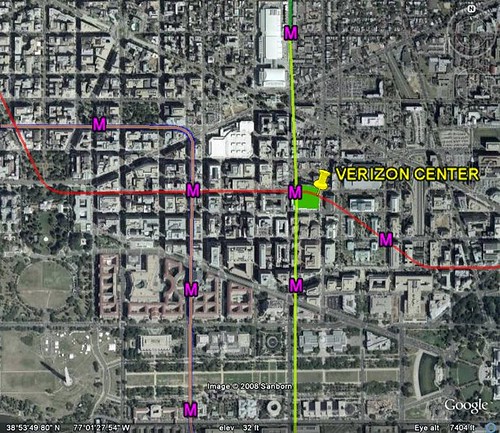Solving sprawl with basketball (reprise)

Posted February 28, 2011 at 1:32PM
This past Saturday, Bill Clinton, basketball legend Alonzo Mourning and I watched a basketball game at Verizon Center in downtown DC. The team that all three of us were rooting for lost, unfortunately, not least because star player Chris Wright (#4 in the photo above) missed the game with a broken hand. Our Georgetown Hoyas were beaten by the better team on the day, archrival Syracuse, which sort of paid us back for the Hoyas’ victory earlier in the month up in Syracuse (when Chris was able to play).
I refer to Chris by his first name because, when you follow a team as closely as I do, and go to the summer league games as well, and the player stays for four years, you really do feel a familiarity and bond. Heck, at the very informal summer league games, it’s not uncommon to get to know the players’ families as well. Basketball is different from, say, football or lacrosse because the players aren’t obscured by uniforms and helmets.
(Don’t worry, I’ll eventually get to a sustainability point in this post.)
Despite the loss, Saturday was special because it was Senior Day, the last home game of the year with a pregame ceremony honoring Chris and his fellow seniors Austin Freeman, Julian Vaughn, and Ryan Dougherty. Austin has been a starter all four years; Chris for three; and Julian for two. Ryan was a reserve but such a locker room leader that coach John Thompson III made him a team captain. These guys have all been class acts (not exactly a given in the world of big-time sports) and I am immensely proud to have had them on my team.
The way that all this connects with smart growth is that the Hoyas, like Washington’s professional teams the Wizards (NBA), Capitals (NHL) and Mystics (WNBA), play in a downtown arena that had a huge role in the immensely successful revitalization of DC’s once-downtrodden old downtown, now called the Penn Quarter.
The story is well-documented, and I’ve told it here in an earlier post of the same name as this one (see also the excellent discussion beginning at p. 68 of this report), so I won’t recount it here in the same way. The hero of the story is then-Wizards/Capitals owner Abe Pollin, who moved his teams from the suburbs to a transit-rich location just a few short blocks from NRDC’s office. He built the arena with his own money, too, at a time when DC was bankrupt (though the city did provide infrastructure).
This was just huge. That part of town had declined severely after the 1968 riots that followed the assassination of Dr. Martin Luther King, Jr. It was a place where few people wanted to be at night, and where very few wanted to be without a parking space close to their destination. Maybe you’d want to go to the heart of Chinatown or, if you were young and adventuresome, to the DC Space art bar or the old 9:30 music club. But you sure as heck would not be likely to be going anywhere in between.
It was a place that had the bones, so to speak, for walkability – a good street grid, sidewalks, building density if not population or successful commercial density – but was devoid of pedestrians. The building of the DC Metro system created some possibility, and the old Pennsylvania Avenue Development Corporation pursued mixed-use development close to the Avenue, several blocks to the south of where Verizon Center now stands (with very limited success). In between Pennsylvania Avenue and the heart of Chinatown on H Street, there was mostly just urban decay.
One can argue that redevelopment would have happened anyway at some point, given the national trend of revitalization of downtowns that we have now seen across the country. But someone had to be first. Mr. Pollin took that risk – almost 20 years ago – in part because he wanted to help catalyze the revitalization, and the area’s transformation began immediately. Now it is one of the most thriving areas of any city’s downtown. As former DC mayor Adrian Fenty put it, “Abe Pollin almost single-handedly revitalized the Gallery Place / Chinatown neighborhood by turning down offers from suburban jurisdictions to finance and build the Verizon Center on 7th Street NW.”
Look at that location, on top of two Metro lines, with a third not far away, and too many bus lines to count. No wonder some 70-80 percent of the arena’s customers are said to use transit to get there. With more and more housing coming into the area, more people are going to walk, too. (If they aren’t sports fans, they can see the likes of Bruce Springsteen or Lady Gaga, both of whom have performed in Verizon Center within the last year; in Gaga’s case, within the last week.)
Before or after the event, they can have their choice of fifty or so nearby restaurants and bars, along with a bunch of shopping venues, too. Heck, most people in the neighborhood now aren’t even there because of the arena, though it’s the arena that made the neighborhood what it has become.
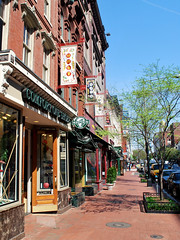 For longtime DC residents (over 40 years for yours truly), the amazing thing is the contrast of Verizon Center with the area’s old sports arena, also built by Pollin (in the early 1970s) in a completely unwalkable and transit-inaccessible suburban location surrounded by acres of asphalt parking lots, and notorious for hours-long traffic jams for people trying to go home after an event.
For longtime DC residents (over 40 years for yours truly), the amazing thing is the contrast of Verizon Center with the area’s old sports arena, also built by Pollin (in the early 1970s) in a completely unwalkable and transit-inaccessible suburban location surrounded by acres of asphalt parking lots, and notorious for hours-long traffic jams for people trying to go home after an event.
DC isn’t the only city to enjoy the benefits of a downtown sports and entertainment venue, of course. New York’s Madison Square Garden, ironically neither near Madison Square nor a garden, sits on top of one of the most walkable and transit-rich locations in the world. Peter Keating of ESPN wrote in 2004 that, since 1985, 58 of 87 new major league stadiums or arenas had been built in or near central business districts of cities. This is a wonderful thing, if you ask me.
Would I have purchased season tickets to see Georgetown basketball if Verizon Center weren’t so convenient? (Probably not, though my NRDC colleague Lisa, who also sits in section 110 two rows away from me, might have; she’s pretty hard-core.) Fortunately, I didn’t have to choose between an awesome location and enjoying the games. Verizon Center gave me both, and thus allowed me the immense pleasure of watching the careers of Austin, Chris, Julian, Ryan and their teammates. Not to mention what I suspect will be the only occasion for which I am in the same room at the same time as Alonzo Mourning and Bill Clinton.
One more thing: I’m also hoping we get another shot at Syracuse in the Big East tournament.
Move your cursor over the images for credit information.
